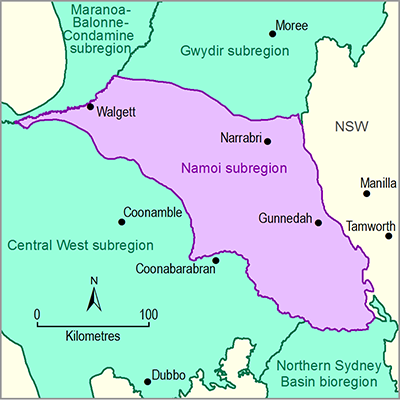- Home
- Assessments
- Bioregional Assessment Program
- Namoi subregion
- 3-4 Impact and risk analysis for the Namoi subregion
- 3.6 Commentary for coal resource developments that are not modelled
- 3.6.2 Potential impacts of non-modelled additional coal resource developments
3.6.2.1 Gunnedah Precinct
The Gunnedah Precinct is a proposed open-cut development located near the Sunnyside Mine, which is now under care and maintenance. While the time frame for groundwater changes resulting from Sunnyside Mine to subside has not yet come to an end, the peak groundwater changes have passed. This means the future risk of cumulative impact from the Gunnedah Precinct on groundwater resources is reduced, assuming extraction of coal from Sunnyside Mine does not resume (there is development consent for this mine until 2020, see companion product 2.1-2.2 for the Namoi subregion (Aryal et al., 2018)).
Groundwater modelling identifies up to 2 m drawdown (Figure ) in the vicinity of the Sunnyside Mine. The effect on groundwater drawdown of the Gunnedah Precinct is likely to be localised and cumulative because of its proximity to the existing Sunnyside Mine and is unlikely to extend to other mines. This is because the probability of exceeding 0.2 m drawdown is approximately 5% within a 10 km distance from any mine (companion product 2.6.2 for the Namoi subregion (Janardhanan et al., 2018)). There is also a potential for cumulative effects on local surface waters including streams, and any hydrological changes have the potential to intersect with the following landscape groups: ‘Dryland remnant vegetation’, ‘Floodplain or lowland riverine’, ‘Human-modified’, ‘Non-floodplain or upland riverine’, and ‘Rainforest’. Impacts to specific ecological, sociocultural and economic assets were not considered in this product but the potential additional hydrological changes described should to be considered in relation to the assets in Section 3.5.
3.6.2.2 Vickery South Coal Project
The open-cut Vickery South Coal Project is an expansion of the future Vickery Coal Project (also an additional coal resource development) and so will have a cumulative impact, overlaying its changes to groundwater with drawdown already in progress from both Vickery and the existing Rocglen Mine (Figure 51). The location of this proposed development suggests the potential for changes to groundwater and surface waters (Figure 51), because the project area is within the alluvium associated with the Namoi River, Driggle Draggle Creek and Stratfort Creek (see companion product 2.1-2.2 for the Namoi subregion (Aryal et al., 2018)).
The hydrological changes associated with the development have the potential to intersect with the following landscape groups: ‘Dryland remnant vegetation’, ‘Floodplain or lowland riverine’, ‘Human-modified’, ‘Non-floodplain or upland riverine’ and ‘Rainforest’. Impacts to specific ecological, sociocultural and economic assets were not considered in this product but the potential additional hydrological changes described should to be considered in relation to the assets in Section 3.5

Product Finalisation date
- 3.1 Overview
- 3.2 Methods
- 3.3 Potential hydrological changes
- 3.4 Impacts on and risks to landscape classes
- 3.4.1 Overview
- 3.4.2 Landscape classes that are unlikely to be impacted
- 3.4.3 'Floodplain or lowland riverine' (non-Pilliga) landscape group
- 3.4.4 'Non-floodplain or upland riverine' (non-Pilliga) landscape group
- 3.4.5 Pilliga riverine (upland and lowland)
- 3.4.6 Potentially impacted landscape classes lacking quantitative ecological modelling
- References
- Datasets
- 3.5 Impacts on and risks to water-dependent assets
- 3.6 Commentary for coal resource developments that are not modelled
- 3.7 Conclusion
- Citation
- Acknowledgements
- Contributors to the Technical Programme
- About this technical product
